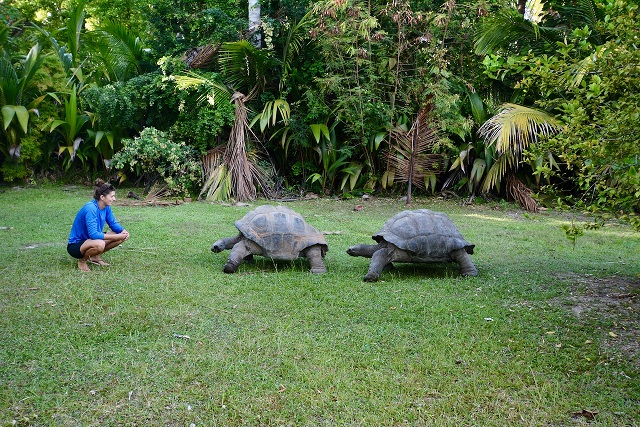Eight Aldabra giant tortoises transported from the Seychelles’ main island of Mahe have settled into new lives and are roaming freely on D’Arros Island, the Save Our Seas Foundation said.
The adult tortoises — five females and three males — were residing in pens on Mahe and as they were deemed to be in good health. The D’Arros research centre took up the opportunity to let them live freely in a new environment.
The giant tortoises were transported in August and after a two-week quarantine they have since successfully integrated with the 21 existing tortoises on D’Arros.
Checking and observing the tortoises, which have now all been marked and numbered, is part of the weekly routine on the island, one in which D’Arros Island Manager Andy Michel and his wife Noella have a particularly deep connection.
As D’Arros does not have a hatchery, Michel has taken it on himself to nurture two smaller tortoises called Ralph and Phouset that were found around the time he arrived on the island in 2018.
He built a pen next to his house to protect them from predators and other dangers, but with the tortoises now having grown larger, he acknowledged it was better to set them free together with the new arrivals.
“It has been heart-breaking. We raised them like children and enjoyed having them close, but I think it’s better for them to be out in nature,” said Michel.
The first tortoise that walked out of the quarantine pen and into its new environment was fittingly named Freedom.
As more were gradually released, the entire island community began to settle into their own unique routines. Among the new arrivals, the older male Jeffrey is living by the airstrip and the beach, and not unlike human elders, seems to prefer peace and tranquillity rather than the company of other tortoises.
The giant tortoises were transported to D’Arros in August. (Save Our Seas Foundation) Photo License: CC-BY
By contrast, the other two new males, Aqua and Oscar, have both acquainted themselves with the local female population. And with the tortoises that the Michel couple raised penned in no longer, the entire Save Our Seas Foundation D’Arros Research Center team hopes a happier and healthier tortoise population will result in a more authentic outer island ecosystem.
The Save Our Seas Foundation said that providing a home to the additional tortoises was an opportunity to add both social and scientific value to the island.
The programme director, Henriette Grimmel, said that the free-roaming tortoises are an important part of daily life for the island’s small community and although the Centre’s worldwide research is largely focused on sharks and rays, the connection between marine and terrestrial conservation in the outer coralline isles cannot be overlooked.
“Land-sea interaction is continuous, and the giant tortoise is an iconic and threatened species endemic to Seychelles. If D’Arros can facilitate a natural facet of Seychelles’ ecology, that must form part of our conservation mission. These tortoises are also an important part of our community, we know each individual and character and many of us on the island have our favourites,” said Gimmel.
Giant tortoises were first brought over to D’Arros in the mid-1970s with just seven individuals on the island initially. In more recent decades, the population had levelled off at around 20 and had been stagnant for some time.
The exact reason for this is unclear, however Grimmel hopes that the new arrivals can be beneficial to the overall population, in part through the addition of more genetic diversity. So far, indications are that the new tortoises have intermingled and mating has been frequent.
The Aldabra giant tortoise is one of the largest tortoises in the world and historically were found on many of the islands in the western Indian Ocean including Seychelles.

